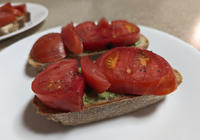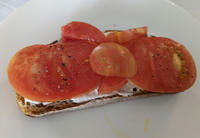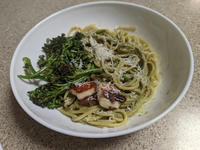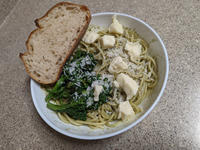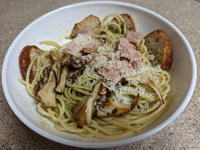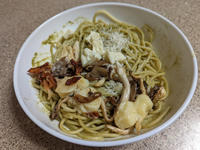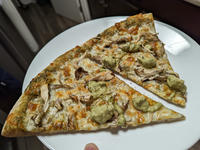Weekly Dinner for Two- Farm to Table
Farmer's Market🔗
I've been thinking of a weekend run to Mountain View farmers market from home via Bayshore then Stevens Creek trail for a while. The plan is to run there (~15k), get some pastry for breakfast, sample a bunch of fruit, get what's good, check out interesting or seasonal vegetables, stop by Far West Fungi for mushrooms, and at the end take the train back.
The brilliant plan finally happened this Sunday! Everything goes as planned with a bonus milk stop at Claravale Farm stand. We got to taste "the best milk you can get in California, freshly milked just last night". Indeed, very clean and crushable, perfect for after run rehydration. See full review here.
Back to the market, we got a variety of very good-looking and good-tasting produce.
- Heirloom tomato
- Italian heirloom broccoli
- Basil
- Oyster mushroom
- Stone fruit: peach and plum
As they represent the best taste of what local farms and this season can offer, I design this week's menu to let their flavor fully shine. Here is what I've come up with.
Heirloom Tomato Tartine🔗
In-season heirloom tomatoes are divine, both in one-of-a-kind swirly color and also the out-of-chart flavor bomb. Cut a thick middle section slice, firm and sweet outer flesh, juicy and succulent inner seed, unified by umami packed tomato flavor explosion. Have a big bite to the center, you are in for the best summer treat. To highlight this thick tomato steak, what's a better way than putting it on a thick slice of good sourdough? A slight tang from the bread, a sweet fragrance from pesto (or a creamy spread of whipped cottage cheese), a simple pinch of salt and pepper. There you have it, a summer garden all in this bright lively open-face sandwich.
Spaghetti con Pesto di Broccole🔗
The big bunch of basil for only $2 is probably the best bargain from the market. Unless growing yourself, fresh basil is a scarcity. On the rare occasions they show up in supermarkets, it's usually in tiny clamshells that brown very soon if not already browned. The fresh bunch from the market is probably just picked in the morning, brightly green without a speckle of brown, large leaves like those loose spinach. The sweet scent is so intense that it's why I spot it in the first place.
Now with this rare guest in town, what's a better time to make pesto? I guess most people equate pesto to basil pine nut garlic, like my beloved A deeply believed before I repeatedly told him the fun fact that I'm gonna give a quick crash course here. Pesto is derived from mortar and pestle, which basically means to mash stuff together to get some kind of paste. The stuff usually involves herbs, nuts, oil, and any kind of strong flavoring things that can be mushed and incorporated into the final emulsification. As we all know, the most classic ingredients to make pesto are basil, pine nuts, garlic and olive oil. That's why many people simply think of pesto as just basil pesto. Now you know pesto is just a template. It doesn't even have to be green. Just blend up some kind of vegetable, some kind of nuts, dilute with some kind of oil or water, sprinkle some seasoning. Get creative and you can make your own pesto.
While all those pesto variations are fun and tasty, classic is still the classic. In particular, the basil fragrance is so enchanting that the air is permeated with the sweet note once unlid the jar. The bunch yields about 1.5 cups of pesto. Below is the recipe. All the measurements are loose as I adjust the seasoning and consistency as I blend.
- 1 bunch of fresh basil, only leaves
- 150g walnut
- 2 heaping spoons of sauerkraut
- olive oil
- cottage cheese
- water
- salt and pepper
You basically just blend up everything till smooth. The only thing to pay attention to is that once basil is blended, it will oxidize and turn brown very quickly, like in seconds. So make sure you have enough acid (in my case is the sauerkraut, vinegar will work too). If it does briefly turn brown after blending, you can still fix it by adding more acid and mixing again. Use a well sealed container for storing. Also, pour a thin layer of oil on top to block contact with oxygen. Next time before use, just stir in the oil on the top. With these storing tips, the pesto lasted the entire week, perfectly green and strongly fragrant. We use pesto as pasta and pizza sauce, with other vegetables from the market as the toppings.
Pizza Funghi🔗
We got two types of mushroom: maitake and tree oyster. Both are excellent in flavor and texture. For more mushroomy jargon description, I found something on the internet (source).
- Maitake (Hen of Woods)
Another “cluster” variety, this type of edible mushroom resembles a head of cabbage. They have a unique earthy, gamey flavor and are soft in texture.
- Tree oyster
Their name is no mistake, oyster mushrooms look, well, like oysters. But imagine oysters in a cluster. Very tender and chewy in texture, oyster mushrooms are light in color and have a mild almost sweet aroma and flavor. Once cooked, oyster mushrooms take on a meaty texture. Use oyster mushrooms in soups, sauces and stir-fries.
My take for the two is both have build-in meaty umami flavor. Just by simple stir-frying with olive oil and seasoning with salt and pepper, they bring so much to the table that you question where are those advanced flavors from. Well, only the magic mycelium network knows. As you've seen above, we tried both on pesto pasta. They are the S-tier toppings for pesto pasta. To make them the star of the show, it's gotta be a mushroom pizza.
Smartly, we can easily swap the support and carry role between mushroom and pesto. In pasta, pesto is the carry as it permeates throughout every bite and mushroom is the support that brings additional beats to the party. On pizza, pesto becomes the support to provide base flavor and mushroom is the carry that shows off its characteristics as the topping. See more recipe details here.
